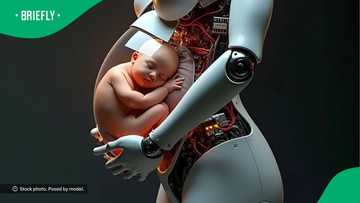“Doesn’t Look Fine”: Cherry Tiggo 9s Deliberately Crash at Launch To Prove Safety, SA Debates
- A local content creator attended the launch of the new Cherry Tiggo 9 and filmed a shocking display of its safety features
- The video was shared on TikTok, where it received significant attention from social media users who were stunned by the dramatic crash test
- Social media users were largely unconvinced by the demonstration, with many questioning the extent of the damage to the vehicles and expressing doubt about the car's safety
- Briefly News spoke with Tendani Muthumuni, the owner of an auto-repair shop, about the Cherry Tiggo 9s' deliberate car collision tests

Source: TikTok
A local car reviewer and content creator caused a stir online after sharing a video of a controlled crash test at a Chinese car brand launch.
The clip, shared by TikTok user @2to4wheelsza, garnered a wide range of reactions from the public.
The man's video shows two brand-new Chery Tiggo 9 vehicles that were deliberately crashed into each other. According to @2to4wheelsza, the cars collided at a speed of 50 km per hour to demonstrate the car's safety and resilience. Both cars were badly crushed in the front, with significant visible damage to both vehicles' exteriors.

Read also
South African woman teaches Americans 'Magumba' dance in slow motion, Mzansi swoons over men
Chery Tiggo 9s put to the test
Despite the shocking appearance of the outside, the man highlighted that the interior of both cars looked remarkably good. He pointed out that there was not much damage to the cabin, suggesting that passengers would likely be well-protected in a real-life accident.
PAY ATTENTION: stay informed and follow us on Google News!

Source: Getty Images
Car expert's explanation behind the crumple zone
We at Briefly News spoke with Tendani Muthumuni, a mechanic and owner of TD Autoworx in Joburg. We asked the man to give us his expert opinion on the Cherry Tiggo 9's crash test and why they were so badly damaged. The man responded:
"The damage you saw is exactly what's supposed to happen. Modern cars are built with crumple zones at the front and back. These zones are designed to collapse and absorb the force of an impact. It might look bad, but it means the car is doing its job by scattering the energy of the crash and preventing it from reaching the passenger cabin. It's an effective design for protecting the people inside."

Read also
A woman’s TikTok showing her massive R5 savings pile went viral and received thousands of reactions in one day
Many social media users were shocked by the damage caused by the 50 km/h. We asked the car expert what he thinks made people doubt the cars' speed. He shared:
"Most people are not trained to understand vehicle safety engineering. They assume that less damage means a safer car, when in fact, the opposite is true. They see a car's body as a solid, unbreakable shield. They don't realise that a rigid car would transfer all that crash energy to the occupants, causing severe injuries.
The scepticism is a result of a common misconception about how cars work in a collision. The damage to the cars is severe, though, I understand why people doubt their speed of travel when the crash test was done. The likelihood that the cars were travelling at 50 km/h is very high, though, even while the crash looks bad."
When asked what such a demonstration teaches us about modern cars and their evolution, Tendani said:
"It shows that the automotive industry has evolved far beyond just making vehicles that go fast. It's a clear demonstration of the shift towards passenger safety as a primary design principle. Modern cars are complex machines built to make driving faster. The old notion of solid is being replaced by smart, where the car strategically deforms to save lives."

Read also
"Our biggest enemies are Eskom and SARS": R1.6K for just 414 units of electricity has SA enraged
South Africa debates the car crashes
The video gained traction online, with many people expressing disbelief and shock at the extent of the damage. Many refused to believe that the car had only been travelling at 50 km per hour, arguing that the front ends were far too crushed for such a low-speed collision. Some users wanted to see the interior damage and the people who were supposedly driving them.
Others with more knowledge about cars explained the purpose of the demonstration. They clarified that the car is designed to crumple outside, as this is how the vehicle absorbs kinetic energy to protect the occupants.
User @cinemaatrequest said:
"Demonstrate with realistic speed, as you know how people drive, not wishful speed."
User @SitheraMsibi🇿🇦🇸🇿🇨🇩🇸🇩 commented:
"People in the comments are missing the point; the front of cars is designed to disintegrate in a collision, to dissipate energy, reducing impact on occupants. The rest of both cars are still intact, so they performed well."

Read also
China set to release 1st pregnancy robot costing R250k, stuns internet: "Little terminators"
User @sifisompumelelo added:
"At 50km/h, so wrecked 😳😳. At 100, everything would be minced meat. Crazy stuff indeed🤞."
User @Breadouzn
"Does not look pretty damn fine to me. Reliability & Safety just dropped. #CherryKiller."
User @khirotshotsho asjed:
"Please show the inside 😳."
User @Proff🇿🇦 said:
"50km 😭, these are plastic cars."
Watch the TikTok video below:
3 Briefly News articles about cars
- A wealthy businesswoman from KwaZulu-Natal turned heads online after collecting her super luxury car, a Bentley Supersports.
- A mining tycoon was filmed in Germany collecting his Mercedes-Benz G63 AMG 6x6 Brabus worth over R20 million, and Mzansi celebrated with him.
- A young lady boldly showed off her old Datsun, which he had just bought for her business, earning much praise online.
PAY ATTENTION: Follow Briefly News on Twitter and never miss the hottest topics! Find us at @brieflyza!
Proofreading by Kelly Lippke, copy editor at Briefly.co.za.
Source: Briefly News

